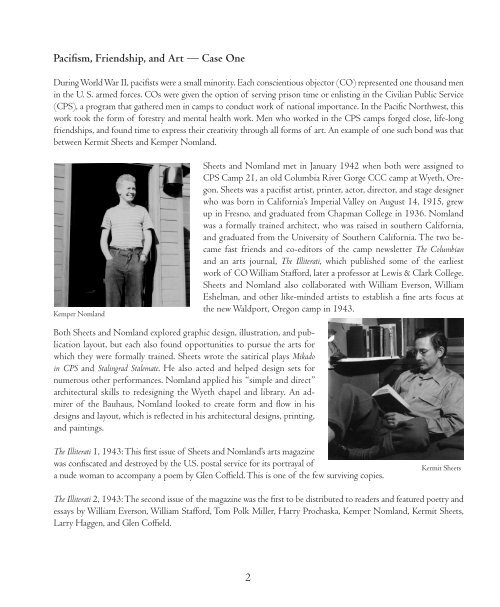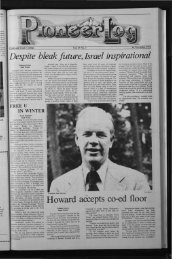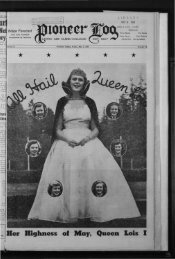Footprints of Pacifism - Lewis & Clark Digital Collections - Lewis ...
Footprints of Pacifism - Lewis & Clark Digital Collections - Lewis ...
Footprints of Pacifism - Lewis & Clark Digital Collections - Lewis ...
You also want an ePaper? Increase the reach of your titles
YUMPU automatically turns print PDFs into web optimized ePapers that Google loves.
<strong>Pacifism</strong>, Friendship, and Art — Case One<br />
During World War II, pacifists were a small minority. Each conscientious objector (CO) represented one thousand men<br />
in the U. S. armed forces. COs were given the option <strong>of</strong> serving prison time or enlisting in the Civilian Public Service<br />
(CPS), a program that gathered men in camps to conduct work <strong>of</strong> national importance. In the Pacific Northwest, this<br />
work took the form <strong>of</strong> forestry and mental health work. Men who worked in the CPS camps forged close, life-long<br />
friendships, and found time to express their creativity through all forms <strong>of</strong> art. An example <strong>of</strong> one such bond was that<br />
between Kermit Sheets and Kemper Nomland.<br />
Kemper Nomland<br />
Both Sheets and Nomland explored graphic design, illustration, and publication<br />
layout, but each also found opportunities to pursue the arts for<br />
which they were formally trained. Sheets wrote the satirical plays Mikado<br />
in CPS and Stalingrad Stalemate. He also acted and helped design sets for<br />
numerous other performances. Nomland applied his “simple and direct”<br />
architectural skills to redesigning the Wyeth chapel and library. An admirer<br />
<strong>of</strong> the Bauhaus, Nomland looked to create form and flow in his<br />
designs and layout, which is reflected in his architectural designs, printing,<br />
and paintings.<br />
Sheets and Nomland met in January 1942 when both were assigned to<br />
CPS Camp 21, an old Columbia River Gorge CCC camp at Wyeth, Oregon.<br />
Sheets was a pacifist artist, printer, actor, director, and stage designer<br />
who was born in California’s Imperial Valley on August 14, 1915, grew<br />
up in Fresno, and graduated from Chapman College in 1936. Nomland<br />
was a formally trained architect, who was raised in southern California,<br />
and graduated from the University <strong>of</strong> Southern California. The two became<br />
fast friends and co-editors <strong>of</strong> the camp newsletter The Columbian<br />
and an arts journal, The Illiterati, which published some <strong>of</strong> the earliest<br />
work <strong>of</strong> CO William Stafford, later a pr<strong>of</strong>essor at <strong>Lewis</strong> & <strong>Clark</strong> College.<br />
Sheets and Nomland also collaborated with William Everson, William<br />
Eshelman, and other like-minded artists to establish a fine arts focus at<br />
the new Waldport, Oregon camp in 1943.<br />
The Illiterati 1, 1943: This first issue <strong>of</strong> Sheets and Nomland’s arts magazine<br />
was confiscated and destroyed by the U.S. postal service for its portrayal <strong>of</strong><br />
a nude woman to accompany a poem by Glen C<strong>of</strong>field. This is one <strong>of</strong> the few surviving copies.<br />
The Illiterati 2, 1943: The second issue <strong>of</strong> the magazine was the first to be distributed to readers and featured poetry and<br />
essays by William Everson, William Stafford, Tom Polk Miller, Harry Prochaska, Kemper Nomland, Kermit Sheets,<br />
Larry Haggen, and Glen C<strong>of</strong>field.<br />
2<br />
Kermit Sheets





